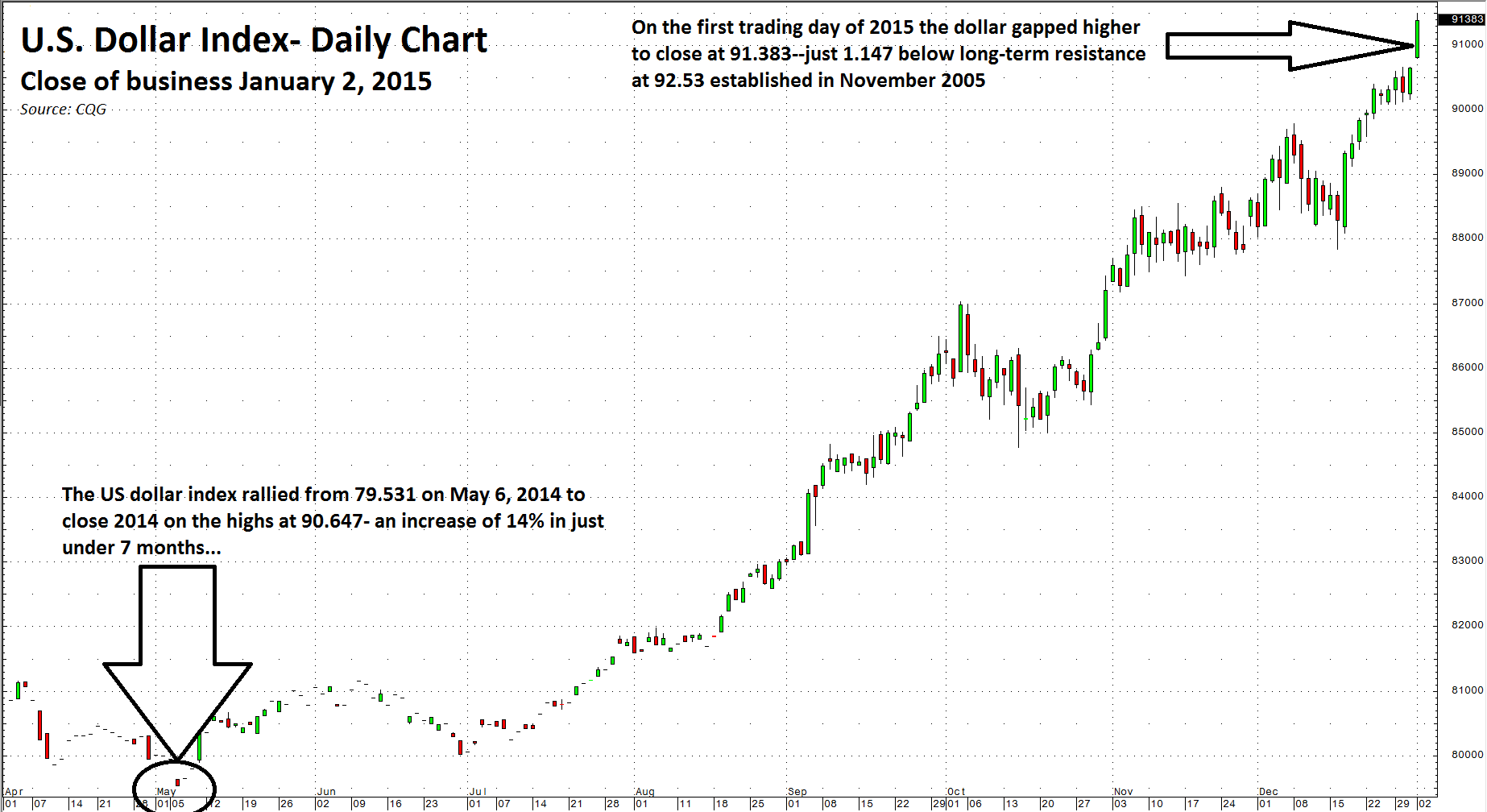The dollar is still the world's reserve currency and there is an inverse relationship between the greenback and commodity prices.
The Dollar and Commodities
In 2014, the dollar was a big winner and many commodities were losers.
As the chart above illustrates, the dollar had a spectacular rally in 2014. From May 6 until the end of the year, the currency rallied 14%. On the first day of trading in 2015, the dollar gapped higher - closing only 1.147 below key resistance at 92.53 - the November 2005 highs.
While the dollar moved higher, many commodity prices went south. NYMEX crude oil dropped over 43% and Brent crude went 46% lower in 2014. Natural gas was down almost 33% on the year while soybeans plunged more than 20%. A stronger dollar weighed on metals as silver shed almost 23% on the year and copper moved more than 15% lower. There were losses in every commodity sector.
There are many reasons for lower commodity prices in 2014, the strength of the US dollar sealed the fate of many commodities and sent values reeling. It is now a new year and there are some lessons we can learn from last year's action.
The Worse Sector of Q3 Was the Best of Q4
The worst performing commodity sector of the third quarter in 2014 was grains. The action was ugly. Soybeans plunged more than 34% during the three-month period, corn was down 23%, and wheat shed 16%. A funny thing happened in the fourth quarter, something that went unnoticed by many. The worst performing sector of Q3 became the best performer of Q4. Soybeans' price rose over 11%, corn was up almost 24%, and wheat increased over 23%. This often happens in commodities. Most eyes were on the energy sector, which fell like a stone in the period between October and December, while the grain markets recovered.
Grains became very cheap during the third quarter, but they could not manage a rally. Any trader or investor who dipped a toe in the water to buy regretted it. Does that sound familiar? It sounds a lot to me like what happened in energy during the quarter that just ended. It is possible that energy, the worst performer of Q4, could stage a grain-like recovery in Q1 of 2015. After all, given the rally in the US dollar and the fact that it is approaching some important levels, all eyes will shift to the greenback.
The trend is your friend and in the dollar, it could be your best friend, as currencies tend to trend better than commodities. A stronger dollar, which finds support from fundamentals - rising US interest rates and strong US economic data, is a problem for many commodity prices. Metals like gold, silver, copper, and others are likely to fall in the face of a major upside breakout in the dollar.
Possibilities for 2015
In 2015, the best bets for commodities could be in those markets that are least sensitive to the dollar. Of course, the example of grains in Q3 and the energy sector in Q4 may make oil, oil products, and natural gas prices good performers based on current price levels. Other long-side possibilities may lie in agricultural markets where prices have moved lower and it is not the dollar, but the weather and other issues that will dictate prices.
If the action on the first trading day of 2015 is any indication, the rally in the dollar is for real. All traders and investors should prepare for a shift of focus from energy markets to the currencies. Personally, I believe there is an excellent chance that the dollar will trade at parody with the Euro in 2015 given current fundamentals. That would be a move bigger than we witnessed in 2014.
Stay tuned...
